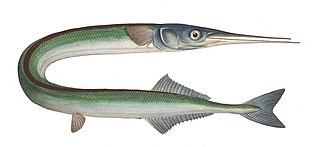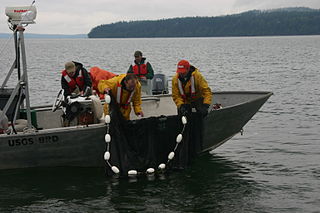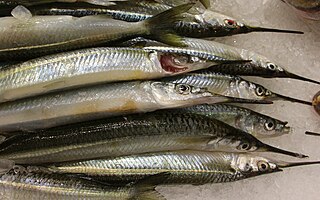
Terra Australis was a hypothetical continent first posited in antiquity and which appeared on maps between the 15th and 18th centuries. Its existence was not based on any survey or direct observation, but rather on the idea that continental land in the Northern Hemisphere should be balanced by land in the Southern Hemisphere. This theory of balancing land has been documented as early as the 5th century on maps by Macrobius, who uses the term Australis on his maps.

The hardhead, also known as the white-eyed duck, is the only true diving duck found in Australia. The common name "hardhead" has nothing to do with the density of the bird's skull, instead referring to the difficulty encountered by early taxidermists in processing the head. Hardheads are found in wetter, coastal regions of Australia, particularly in the south-east, but are known to disperse as far afield as New Guinea, New Zealand, and the Pacific Islands.

The southern right whale is a baleen whale, one of three species classified as right whales belonging to the genus Eubalaena. Southern right whales inhabit oceans south of the Equator, between the latitudes of 20° and 60° south. In 2009 the global population was estimated to be approximately 13,600.
Hemiramphidae is a family of fishes that are commonly called halfbeaks, spipe fish or spipefish. They are a geographically widespread and numerically abundant family of epipelagic fish inhabiting warm waters around the world. The halfbeaks are named for their distinctive jaws, in which the lower jaws are significantly longer than the upper jaws. The similar viviparous halfbeaks have often been included in this family.

The garfish, also known as the garpike or sea needle, is a pelagic, oceanodromous needlefish found in brackish and marine waters of the Atlantic Ocean and the Mediterranean, Caribbean, Black, and Baltic Seas.

Hyporhamphus ihi, the known as the garfish, piper or by its Māori name takeke, is a halfbeak found all around New Zealand in shallow inshore waters.

The common blossom bat also known as the southern blossom bat or Queensland blossom bat, is a megabat in the family Pteropodidae. The common blossom bat feeds mostly on nectar and pollen rather than fruit. It is one of eight Pteropodidae species on mainland Australia. It is one of the smallest of all nectarivorous megabats.

Captain Matthew Flinders was a British navigator and cartographer who led the first inshore circumnavigation of mainland Australia, then called New Holland. He is also credited as being the first person to utilise the name Australia to describe the entirety of that continent including Van Diemen's Land, a title he regarded as being "more agreeable to the ear" than previous names such as Terra Australis.

The Dussumier's halfbeak, also known as the slender garfish, lives in reefs and shallow lagoons. It is an Indo-Pacific species which is found from the Seychelles east to the Tuamotu Islands, north to Hong Kong and Okinawa and south to northern Australia. They form schools which are found near the surface of lagoons and seaward reefs. The longest known specimen was 38.0 cm in length. This species was described by Achille Valenciennes in 1847 with the type locality given as the Seychelles. The specific name honours the French voyager and merchant Jean-Jacques Dussumier (1792-1883).

The little bent-wing bat or little long-fingered bat is a species of vesper bat in the family Miniopteridae. It is found in Australia, Indonesia, the Philippines, and Vanuatu.

Hyporhamphus is a genus of halfbeaks. The species in this genus are distributed throughout the warmer seas of the world, most species being Indo-Pacific and there are some freshwater species.

Dryococelus australis, commonly known as the Lord Howe Island stick insect or tree lobster, is a species of stick insect that lives on the Lord Howe Island Group. It is the only member of the monotypic genus Dryococelus. Thought to be extinct by 1920, it was rediscovered in 2001. It is extirpated in its largest former habitat, Lord Howe Island, and has been called "the rarest insect in the world", as the rediscovered population consisted of 24 individuals living on the small islet of Ball's Pyramid.

A lampara net is a type of fishing net. It is a surrounding net having the shape of a spoon or a dustpan with a short leadline under a longer floatline. The net has a central bunt to contain the fish and two lateral wings.

Pelican Lagoon is a seawater lagoon in the Australian state of South Australia located on the north coast of Kangaroo Island about 18.7 kilometres south east of Kingscote. It was named by Matthew Flinders on 4 April 1802 after the large population of pelicans present in its waters and adjoining shorelines. Its role as fishery hatchery had been identified by the early 20th century with the result that fishing in its waters has been restricted in varying degrees.
The black-tipped halfbeak, Hyporhamphus neglectissimus, is a halfbeak from the family Hemiramphidae.
Hyporhamphus neglectus is a halfbeak from the family Hemiramphidae.
The feathered river garfish, also known as the estuarine halfbeak, spoon-fin garfish, spoon-fin river garfish and viviparous half beak, is a species of marine, freshwater, brackish and reef-associated oceanodromous viviparous halfbeak found in Indo-Pacific regional countries, such as Kenya, Mozambique, Seychelles, Madagascar, New Guinea, Solomon Islands, Australia, New Caledonia, Fiji, Sri Lanka, India, Vanuatu, Malaysia, Thailand, Singapore and Samoa.
Hyporhamphus affinis, the tropical halfbeak, tropical garfish, insular halfbeak or coral reef halfbeak, is a species of schooling marine fish from the family Hemiramphidae. It is distributed through the Indo-Pacific regions and has been recorded in the Mediterranean Sea which it reached through the Suez Canal.

Hyporhamphus regularis is a halfbeak garfish from the family Hemiramphidae. It is found in Australian waters. The red tip on the lower jaw is an identification feature.

Hyporhamphus melanochir, or Southern garfish or garfish, is a halfbeak garfish from the family Hemiramphidae. It is found in southern Australian and New Zealand waters. It is a very popular fish for recreational fishing and eating in Australia, where it is referred to simply as 'garfish' or 'gar'.















